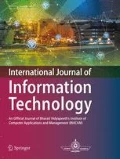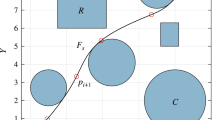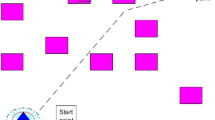Abstract
This paper proposes the right and left motor velocity based multi-objective genetic algorithm controlled navigation method for Two-Wheeled Pioneer P3-DX Robot (TWPR) in Virtual Robot Experimentation Platform (V-REP) software scenarios. The first objective function is made by taking front, left, and right ultrasonic sensors data and right motor velocity. Similarly, the second objective function is designed using front, left, and right ultrasonic sensors data and left motor velocity. Next, the sensor data are considered independent variables or inputs. The velocities of the motors are chosen as dependent variables or outputs for making multi-objective fitness functions for genetic algorithm (GA). This multi-objective GA makes a sensor-actuator control architecture and helps the TWPR to avoid the obstacles in the simulated scenarios. Further, the successful simulation test results show that the multi-objective GA provided a collision-free smooth, and shortest path for TWPR compared to the previously developed benchmark single objective GA.











Similar content being viewed by others
References
Panahandeh P, Alipour K, Tarvirdizadeh B, Hadi A (2019) A kinematic Lyapunov-based controller to posture stabilization of wheeled mobile robots. Mech Syst Signal Process 134:106319–106337. https://doi.org/10.1016/j.ymssp.2019.106319
Pandey A, Kashyap AK, Parhi DR, Patle BK (2019) Autonomous mobile robot navigation between static and dynamic obstacles using multiple ANFIS architecture. World J Eng 16(2):275–286. https://doi.org/10.1108/WJE-03-2018-0092
Upadhyay S, Ratnoo A (2018) A point-to-ray framework for generating smooth parallel parking maneuvers. IEEE Robot Autom Lett 3(2):1268–1275. https://doi.org/10.1109/LRA.2018.2795655
Wang B, Li S, Guo J, Chen Q (2018) Car-like mobile robot path planning in rough terrain using multi-objective particle swarm optimization algorithm. Neurocomputing 282:42–51. https://doi.org/10.1016/j.neucom.2017.12.015
Bayat F, Najafinia S, Aliyari M (2018) Mobile robots path planning: electrostatic potential field approach. Exp Syst Appl 100:68–78. https://doi.org/10.1016/j.eswa.2018.01.050
Mac TT, Copot C, Tran DT, De Keyser R (2017) A hierarchical global path planning approach for mobile robots based on multi-objective particle swarm optimization. Appl Soft Comput 59:68–76. https://doi.org/10.1016/j.asoc.2017.05.012
de Camargo JTF, de Camargo EAF, Veraszto EV, Barreto G, Cândido J, Aceti PAZ (2019) Route planning by evolutionary computing: an approach based on genetic algorithms. Procedia Comput Sci 149:71–79. https://doi.org/10.1016/j.procs.2019.01.109
Martínez R, Castillo O, Aguilar LT (2009) Optimization of interval type-2 fuzzy logic controllers for a perturbed autonomous wheeled mobile robot using genetic algorithms. Inf Sci 179(13):2158–2174. https://doi.org/10.1016/j.ins.2008.12.028
Castillo O, Trujillo L, Melin P (2007) Multiple objective genetic algorithms for path-planning optimization in autonomous mobile robots. Soft Comput 11(3):269–279. https://doi.org/10.1007/s00500-006-0068-4
Mohanta JC, Parhi DR, Patel SK (2011) Path planning strategy for autonomous mobile robot navigation using Petri-GA optimisation. Comput Electr Eng 37(6):1058–1070. https://doi.org/10.1016/j.compeleceng.2011.07.007
Patle BK, Parhi DRK, Jagadeesh A, Kashyap SK (2018) Matrix-binary codes based genetic algorithm for path planning of mobile robot. Comput Electr Eng 67:708–728. https://doi.org/10.1016/j.compeleceng.2017.12.011
Song B, Wang Z, Sheng L (2016) A new genetic algorithm approach to smooth path planning for mobile robots. Assem Autom 36(2):138–145. https://doi.org/10.1108/AA-11-2015-094
Martínez R, Castillo O, Aguilar LT (2008) Intelligent control for a perturbed autonomous wheeled mobile robot using type-2 fuzzy logic and genetic algorithms. J Autom Mob Robot Intell Syst 2:12–22. https://doi.org/10.14313/JAMRIS/2-2008/32
Zhang X, Zhao Y, Deng N, Guo K (2016) Dynamic path planning algorithm for a mobile robot based on visible space and an improved genetic algorithm. Int J Adv Robot Syst 13(3):1–17. https://doi.org/10.5772/63484
Narasimhan GE, Bettyjane J (2020) Implementation and study of a novel approach to control adaptive cooperative robot using fuzzy rules. Int J Inf Technol. https://doi.org/10.1007/s41870-020-00459-z
Wang M (2021) Real-time path optimization of mobile robots based on improved genetic algorithm. J Syst Control Eng 235(5):646–651. https://doi.org/10.1177/0959651820952207
Teli TA, Wani MA (2021) A fuzzy based local minima avoidance path planning in autonomous robots. Int J Inf Technol 13(1):33–40. https://doi.org/10.1007/s41870-020-00547-0
Yasin JN, Mohamed SA, Haghbayan MH, Heikkonen J, Tenhunen H, Plosila J (2021) Low-cost ultrasonic based object detection and collision avoidance method for autonomous robots. Int J Inf Technol 13(1):97–107. https://doi.org/10.1007/s41870-020-00513-w
Khan H, Khatoon S, Gaur P (2021) Comparison of various controller design for the speed control of DC motors used in two wheeled mobile robots. Int J Inf Technol 13:713–720. https://doi.org/10.1007/s41870-020-00577-8
Jiang M, Fan X, Pei Z, Jiang J, Hu Y, Wang Q (2014) Robot path planning method based on improved genetic algorithm. Sensors & Transducers 166(3):255–260
Author information
Authors and Affiliations
Corresponding author
Ethics declarations
Conflict of interest
The authors declare that there is no conflict of interests.
Rights and permissions
About this article
Cite this article
Panwar, V.S., Pandey, A. & Hasan, M.E. Motor velocity based multi-objective genetic algorithm controlled navigation method for two-wheeled pioneer P3-DX robot in V-REP scenario. Int. j. inf. tecnol. 13, 2101–2108 (2021). https://doi.org/10.1007/s41870-021-00731-w
Received:
Accepted:
Published:
Issue Date:
DOI: https://doi.org/10.1007/s41870-021-00731-w




